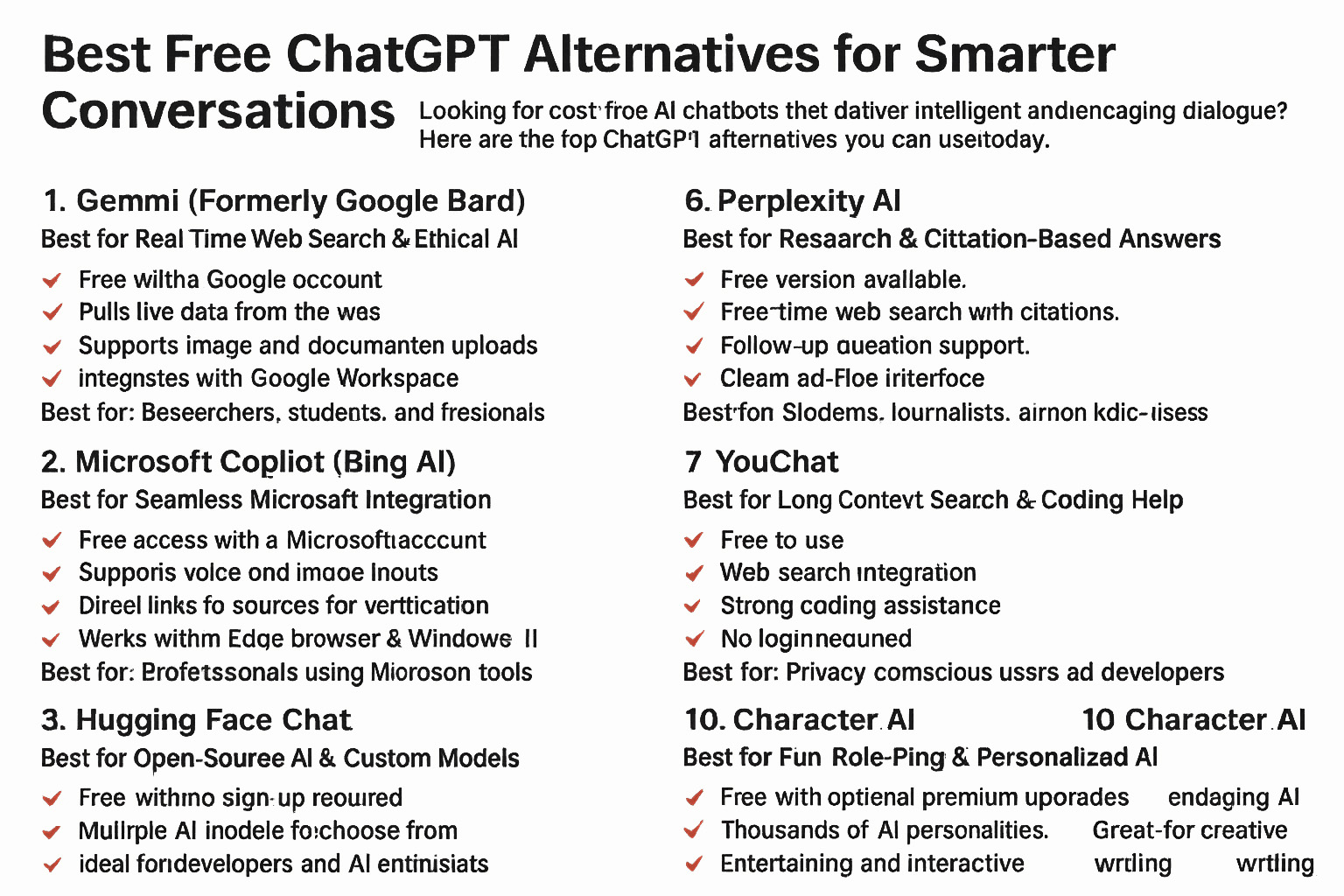Introduction: Why Look Beyond ChatGPT?
In today’s fast-moving AI landscape, ChatGPT has become synonymous with AI-powered conversations. However, several compelling alternatives now offer unique advantages – whether it’s better accuracy, specialized features, or simply free access to powerful capabilities. As AI continues evolving at breakneck speed, 2024 brings us exciting new options that might better suit your specific needs.
This guide explores seven exceptional free alternatives to ChatGPT, each with distinct strengths for different use cases. From research assistants to coding companions and creative writing partners, discover which AI chatbot could become your new favorite digital collaborator.
1. Gemini (Google’s AI Assistant) – Best for Real-Time Information
Formerly known as Bard, Google’s Gemini represents the search giant’s most advanced conversational AI to date. What sets it apart is direct access to current web information – a crucial advantage over ChatGPT’s knowledge cutoff.
Key Strengths:
-
Pulls live data from Google’s index for up-to-date answers
-
Seamless integration with Google Workspace apps
-
Supports image analysis and document uploads
-
Free with Google account
Perfect For: Researchers, students, and professionals who need accurate, cited information without paying for ChatGPT Plus.
Limitation: Can sometimes prioritize search results over original analysis compared to ChatGPT.
2. Claude 3 (Anthropic) – Most Thoughtful Responses
Anthropic’s Claude 3 has gained recognition for its exceptional reasoning abilities and commitment to safe, ethical AI interactions. The free version offers robust capabilities that rival ChatGPT’s quality.
Standout Features:
-
Industry-leading context retention (up to 200K tokens)
-
Exceptional at summarizing and analyzing documents
-
More cautious about misinformation than competitors
-
Pleasant, natural conversation style
Best Used For: Analyzing long documents, ethical discussions, and situations requiring nuanced responses.
Note: Free tier has daily message limits, but generous enough for most personal use.
3. Microsoft Copilot – Best Integration with Windows
Microsoft’s rebranded AI assistant (formerly Bing Chat) combines OpenAI’s GPT-4 technology with deep Windows integration, making it a powerhouse for productivity.
Why Choose Copilot:
-
Free access to GPT-4 level intelligence
-
Built directly into Windows 11 and Edge browser
-
Creates AI images through DALL-E integration
-
Provides source citations for factual claims
Ideal For: Windows users who want AI assistance across documents, emails, and web browsing.
Pro Tip: Use the “Precise” mode for more accurate, concise responses similar to ChatGPT.
4. Perplexity AI – The Research Powerhouse
Perplexity has carved its niche as the go-to AI for serious researchers and curious minds. It combines large language model smarts with a search engine’s freshness.
Research Advantages:
-
Automatically cites sources for all factual statements
-
Allows follow-up questions for deeper dives
-
Clean, distraction-free interface
-
Free version covers most personal needs
Superior To ChatGPT When: You need verifiable information with sources, not just plausible-sounding answers.
Bonus: The “Copilot” feature (different from Microsoft’s) offers guided research assistance.
5. DeepSeek Chat – Best for Technical Users
This rising star in the AI world offers surprisingly advanced capabilities for a completely free service, particularly in technical domains.
Technical Edge:
-
Handles complex math and coding problems exceptionally well
-
Supports 128K context window for long conversations
-
Allows file uploads (PDFs, Word, Excel) for analysis
-
No login required for basic use
Programmers Will Appreciate: Its ability to explain and debug code in multiple languages.
Hidden Gem: Performs well in non-English languages, especially Chinese.
6. Hugging Face Chat – The AI Playground
Hugging Face hosts multiple open-source models you can chat with for free, making it perfect for comparing different AI approaches.
Why It’s Unique:
-
Access to various models like Llama 3 and Mistral in one place
-
Completely free with optional account
-
Great for understanding different AI strengths
-
Developer-friendly with API access
Best For: Tech enthusiasts who want to experiment with different AI models.
Try This: Compare responses from different models to the same prompt.
7. Poe by Quora – All-in-One AI Hub
Quora’s Poe platform lets you access multiple top AI models through a single interface, with free daily access to several including ChatGPT.
Multi-Model Access:
-
Chat with Claude, GPT-3.5, and other models
-
Create custom chatbot personas
-
Mobile apps available
-
Simple, intuitive interface
Great When: You want to quickly compare how different AIs handle your query.
Limitation: Free tier has strict message limits on premium models.
Comparison Table: Which AI Should You Choose?
| Use Case | Best Alternative | Why Better Than ChatGPT |
|---|---|---|
| Current Events & Research | Gemini | Accesses live web data |
| Document Analysis | Claude 3 | Handles long documents better |
| Windows Users | Microsoft Copilot | Deep system integration |
| Verified Sources | Perplexity AI | Automatic citations |
| Coding & Math | DeepSeek Chat | Technical specialization |
| Model Comparison | Hugging Face | Multiple AIs in one place |
| Casual Experimentation | Poe | Easy access to various models |
Conclusion: Expanding Your AI Toolkit
While ChatGPT remains a versatile option, these seven alternatives each bring something special to the table – whether it’s Gemini’s real-time knowledge, Claude’s careful reasoning, or Perplexity’s research rigor. The best approach? Bookmark several and use each for its strengths.
Remember that the AI landscape changes rapidly. Many of today’s free services may introduce premium tiers, while new competitors emerge regularly. The smart strategy is staying informed about developments while enjoying the current wealth of free, powerful alternatives to ChatGPT.
Final Tip: For maximum productivity, consider using different AIs for different tasks – Claude for writing, Perplexity for research, and DeepSeek for technical work, for example. This “ensemble approach” leverages the unique strengths of each platform.
